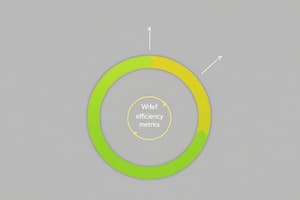Podcast
Questions and Answers
What is the classical definition of areflexia in spinal cord injury?
What is the classical definition of areflexia in spinal cord injury?
- All reflexes are absent
- Areflexia in the initial period of the injury (correct)
- Reactive reflexes return immediately after injury
- Areflexia is present for all patients
Which syndrome is characterized by loss of power and reduced pain and temperature sensation below the lesion?
Which syndrome is characterized by loss of power and reduced pain and temperature sensation below the lesion?
- Brown-Sequard syndrome
- Posterior cord syndrome
- Anterior cord syndrome (correct)
- Central cord syndrome
Which imaging technique is considered the investigation of choice for spinal injuries after initial assessment?
Which imaging technique is considered the investigation of choice for spinal injuries after initial assessment?
- Plain X-rays
- Ultrasound
- MRI
- Helical CT (correct)
What should the first X-ray of the cervical spine demonstrate?
What should the first X-ray of the cervical spine demonstrate?
Which of the following statements regarding spinal injury classification is true?
Which of the following statements regarding spinal injury classification is true?
What is typically a major consideration when evaluating spinal injuries?
What is typically a major consideration when evaluating spinal injuries?
Which of the following reflexes indicates the end of spinal shock in supra-sacral lesions?
Which of the following reflexes indicates the end of spinal shock in supra-sacral lesions?
In central cord syndrome, which part of the body is typically more affected?
In central cord syndrome, which part of the body is typically more affected?
Which imaging techniques are considered helpful tools for managing spinal cord injury patients?
Which imaging techniques are considered helpful tools for managing spinal cord injury patients?
What is the primary benefit of performing decompression surgery within the first 24 hours after a spinal cord injury?
What is the primary benefit of performing decompression surgery within the first 24 hours after a spinal cord injury?
Which measurement indicates respiratory failure requiring ventilatory support?
Which measurement indicates respiratory failure requiring ventilatory support?
What condition is commonly caused by complete or partial paralysis of the intercostal muscles in spinal cord injuries?
What condition is commonly caused by complete or partial paralysis of the intercostal muscles in spinal cord injuries?
According to the analyses on spinal cord injury recovery, what percentage of patients are expected to recover two or more motor levels after one year?
According to the analyses on spinal cord injury recovery, what percentage of patients are expected to recover two or more motor levels after one year?
What is a crucial aspect of managing respiratory complications in spinal cord injury patients?
What is a crucial aspect of managing respiratory complications in spinal cord injury patients?
What is the most common cause of post-traumatic shock in spinal cord injury patients with associated injuries?
What is the most common cause of post-traumatic shock in spinal cord injury patients with associated injuries?
What should spinal cord injury centers be able to offer at any time?
What should spinal cord injury centers be able to offer at any time?
Flashcards are hidden until you start studying
Study Notes
Areflexia and Spinal Shock
- Areflexia may occur initially after spinal injury; not all reflexes will be absent.
- Spinal shock resolves with the return of the bulbocavernosus reflex in supra-sacral lesions.
- Consider spinal shock if the patient shows hypotension combined with bradycardia.
Partial Spinal Cord Injury Syndromes
- Anterior Cord Syndrome: Characterized by loss of motor power and reduced pain and temperature sensation below the injury site.
- Central Cord Syndrome: Greater impact on arm function compared to leg function.
- Posterior Cord Syndrome: Lost proprioception below the level of the injury.
- Brown-Sequard Syndrome: Weakness and proprioception loss on the injured side; normal motor and temperature sensation on the opposite side.
Radiological Investigations
- Cervical Spine: Initial imaging includes a lateral X-ray showing C7/T1. Anterior-posterior (AP) views, open mouth, and potentially swimmers views are necessary.
- Interpret X-ray results using ABC rules: Alignment, Bones, Cartilage, and Soft tissues.
- CT Scans: Helical CT surpasses conventional X-rays in sensitivity and specificity, particularly for occipito-cervical and cervico-thoracic junctions.
Thoracic and Lumbar Spine
- Double-level injuries occur in 10-20% of cases, necessitating evaluation of spinal stability.
- Various classification systems exist; AO spine classification revised in 2013, while TLICS (published November 2013) remains widely adopted.
Further Investigations
- Mandatory ATLS guidelines recommend chest X-ray, pelvic view, and assessment of injured areas.
- CT and MRI scans assist in surgical management and diagnostics but rarely change treatment strategies.
Surgical Management
- STASCIS Study (Fehlings et al., 2013): Indicates decompression within the first 24 hours post-SCI enhances neurological outcomes.
- Spinal Recovery: Analysis from Sygen database shows 30% of patients recover to incomplete SCI, and after a year, up to 70% recover at least one motor level, with 30% regaining two or more levels.
- Both conservative and surgical management should be available at specialized spinal cord injury centers.
Early Management and Complications
- Respiratory Complications: Common in high-level spinal cord injuries due to intercostal paralysis and limited respiratory function.
- In paraplegic patients, rib fractures and pulmonary contusions may complicate respiratory issues.
- Regular physiotherapy and monitoring of respiratory parameters (oxygen saturation, vital capacity, blood gases) are essential.
- A vital capacity below 15ml/kg and rising PCO2 suggest respiratory failure, which may require ventilatory support.
Cardiovascular Complications
- Post-traumatic shock often arises from hemorrhage related to associated injuries and requires prompt treatment.
- Recognition of sympathetic nervous system involvement is critical in managing traumatic tetraplegia.
Studying That Suits You
Use AI to generate personalized quizzes and flashcards to suit your learning preferences.



